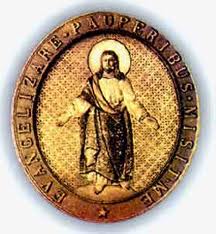For the first time, modern readers have a thoroughly-researched History of the Congregation of the Mission based on original documents and the studies of numerous scholars, past and present.
John Rybolt, CM, noted Vincentian scholar, tells the story of the Congregation of the Mission or Vincentian priests and brothers who have worked to improve others’ spiritual and material welfare for almost four centuries.
Volumes 1-3 are already available. Volumes 4-6 will be available respectively in the Spring of 2014, the Fall of 2014, and the Spring of 2015.
Contact eyoung1@depaul.edu, about pre-publication discounts.
Volume 1
 Their mission was humble and simple: to reach the poor country people, who suffered from ignorance of their faith, a debased clergy, and poverty. In response, Vincent de Paul defined the vocation of his “Little Company” as preaching local missions for free, educating the clergy, and working to relieve the people’s poverty.
Their mission was humble and simple: to reach the poor country people, who suffered from ignorance of their faith, a debased clergy, and poverty. In response, Vincent de Paul defined the vocation of his “Little Company” as preaching local missions for free, educating the clergy, and working to relieve the people’s poverty.
Soon, this vocation was complicated by commands to minister to royal families, including Louis XIV of France and the kings and queens of Poland, which would embroil the Vincentians in international and ecclesiastical politics. In addition, they would begin dangerous foreign missions, such as ministering to the Christian captives of the Barbary pirates, the debased colonists and rebellious natives of Madagascar, and the vendetta-prone Corsicans.
Volume 2
The canonization of Vincent de Paul gave the Congregation of the Mission increased esteem and new opportunites. A new generation of Missioners sought to adapt their founder’s mission of evangelizing the poor to new challenges and territories. As the Congregation expanded dramatically, its internal and external conflicts grew. The burning contention was whether it was a French congregation with branches in other countries or one that adapted itself to each country and people it served.
 Less acute but intense struggles centered on whether new works enriched or diluted the Congregation’s mission. Did increasing work in French seminaries leave too few resources for parish missions to the poor? Did extensive work in Polish parishes go against St. Vincent’s wish to minimize this work? When the Jesuits were suppressed, how could the Missioners handle being thrust into unfamiliar cultures (China, India, and the Middle East) without suitable training? How did the Congregation’s brilliant intellectual center of the Alberoni College accord with the practical training of good pastors and the Church’s conservatism? How could the members resolve their divisions over Jansenism?
Less acute but intense struggles centered on whether new works enriched or diluted the Congregation’s mission. Did increasing work in French seminaries leave too few resources for parish missions to the poor? Did extensive work in Polish parishes go against St. Vincent’s wish to minimize this work? When the Jesuits were suppressed, how could the Missioners handle being thrust into unfamiliar cultures (China, India, and the Middle East) without suitable training? How did the Congregation’s brilliant intellectual center of the Alberoni College accord with the practical training of good pastors and the Church’s conservatism? How could the members resolve their divisions over Jansenism?
In the first part of the century, the Congregation largely benefitted from ties to rulers who saw themselves as furthering the work of the Church through financial support, assignments to parishes and other stations, and protection from inimical foreign powers. Even then, however, there arose delicate questions of loyalty between the rulers and the popes, who sought to reclaim powers from the rulers, especially those in France. As the century progressed, a new generation of rulers openly seized power from the Church. These increasingly foreshadowed the French Revolution’s suppressions and persecutions.
Volume 3
 The French Revolution nearly destroyed the Vincentians in France, and those in most other countries were isolated, persecuted in every degree from niggling regulations to imprisonment and martyrdom, and sometimes squeezed into oblivion. To these external miseries were added painful internal schisms: the Italians, abetted by other countries and the Vatican, pushed to move the Congregation’s headquarters to Rome; interdicts against communications with foreign superiors forced provinces in many countries to act autonomously; national pressures to swear loyalty and conform to compromising regulations created splits within the community and threatened to divide the Daughters of Charity and separate them from their brothers.
The French Revolution nearly destroyed the Vincentians in France, and those in most other countries were isolated, persecuted in every degree from niggling regulations to imprisonment and martyrdom, and sometimes squeezed into oblivion. To these external miseries were added painful internal schisms: the Italians, abetted by other countries and the Vatican, pushed to move the Congregation’s headquarters to Rome; interdicts against communications with foreign superiors forced provinces in many countries to act autonomously; national pressures to swear loyalty and conform to compromising regulations created splits within the community and threatened to divide the Daughters of Charity and separate them from their brothers.
Reduced membership and funding crippled the Vincentians’ efforts as they emerged from the worst of the state obstructions. Nevertheless, they began rebuilding and even made struggling beginnings in overseas missions, notably the United States, Brazil, Turkey, the Middle East, and China, where the martyrdom of two missionaries galvanized interest in this distant and challenging mission.
If pre-orders come through me at eyoung1@depaul.edu, the purchaser will experience a significant discount. Currently the volumes are averaging $40 to $41 if ordered through Amazon.com or through Barnes & Nobel. If we receive payment for a pre-order, we will send the volumes already in print followed by the remaining volumes as each becomes available. If there is any additional information you might need, please contact me. I certainly appreciate anything you can do to get the word out about this important series. Ed Young
Tags: CM, Congregation of the Mission, John Rybolt

